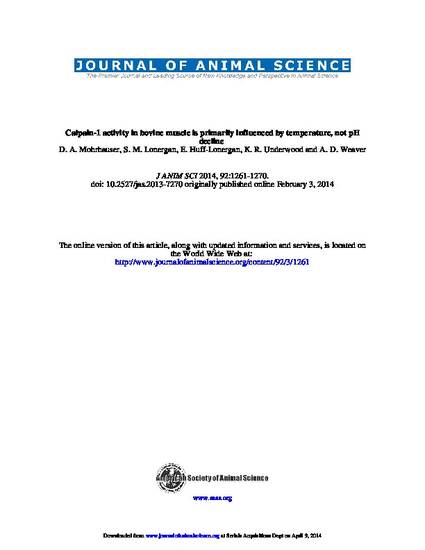
The objectives of this study were to 1) determine the conditions (temperature and pH) that exist in early postmortem muscle of normally chilled and delay chilled beef carcasses to provide a model for in vitro work and 2) determine the mechanism by which early postmortem temperature/pH conditions found in beef muscle influence the enzymes that regulate the aging process in vitro. For objective 1, 7 finished beef animals (HCW 385 ± 8 kg) were harvested with the right sides subjected to normal chilling (2.3°C) approximately 1.25 h postmortem and the left sides subjected to ambient temperature (delay chilling; 22.6°C) for an additional 4.75 h postmortem and then allowed to chill at 2.3°C. Delay chilled carcasses had a more rapid pH decline (P < 0.05) and a slower rate of carcass cooling (P < 0.05). No differences were observed between normally chilled and delay chilled samples for sarcomere length or postmortem proteolysis of troponin T (TnT; P > 0.10). Warner-Bratzler shear force (WBSF) was reduced in steaks from normally chilled carcasses at 14 d (P < 0.05), while results indicated a strong, positive correlation between 14-d WBSF and 3-h longissimus dorsi muscle (LM) temperature (r = 0.67, P < 0.01) as well as a strong, negative correlation between 14-d WBSF and 6-h LM pH (r = –0.65, P < 0.02). These results were used to design the methodology for objective 2, where isolated myofibrils were subjected to μ-calpain digestion at 4 or 22°C with either a fast or slow initial pH decline. As expected, digestions with a fast initial pH decline had lower pH values in the early time points of the incubation (P < 0.05). No differences were detected in μ-calpain activity or in the degradation of intact TnT between the fast and slow pH decline treatments (P > 0.10); however, warmer digestions resulted in a tendency for increased activation of μ-calpain (P < 0.10) and a significant reduction in intact TnT (P < 0.05). Additionally, a temperature × time interaction was revealed in μ-calpain activity and in the degradation of intact TnT (P < 0.05). Specifically, assayed calpain activity was lower at 0.17, 0.33, 1, and 3 h and greater at 72 h in warmer digestions, while intact TnT disappearance was greater as both time and digestion temperature increased. Meat aging and μ-calpain activity are influenced by both temperature and pH, but more research is necessary to fully realize their relationships.
Available at: http://works.bepress.com/elisabeth_huff-lonergan/9/

This article is from Journal of Animal Science 92 (2014): 1261–1270, doi:10.2527/jas.2013-7270. Posted with permission.